



























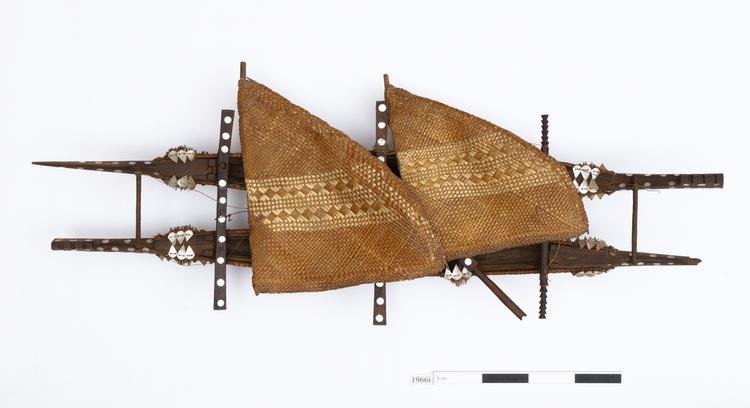

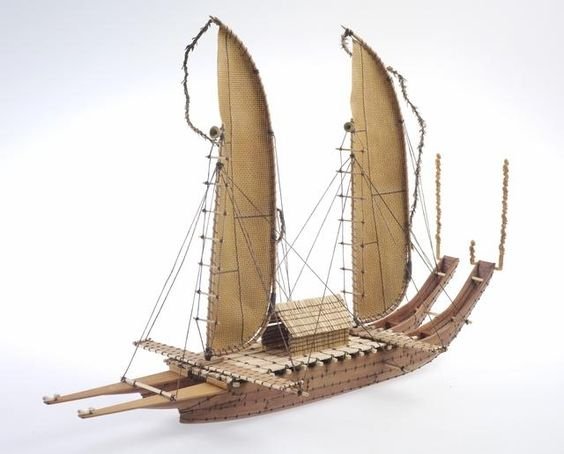









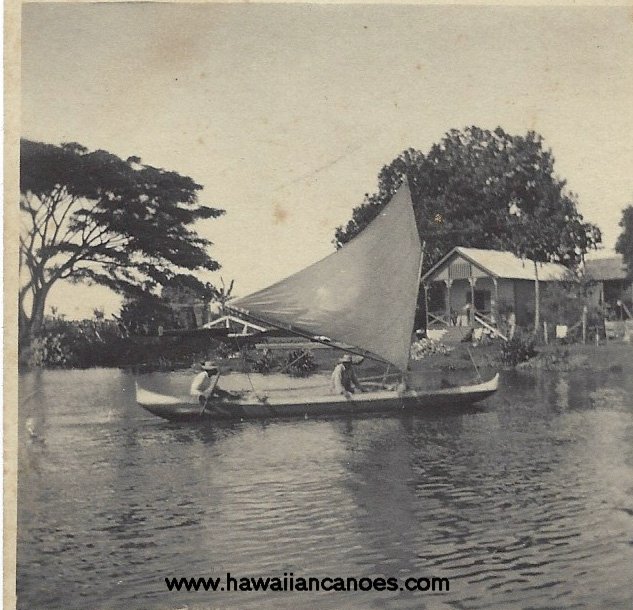















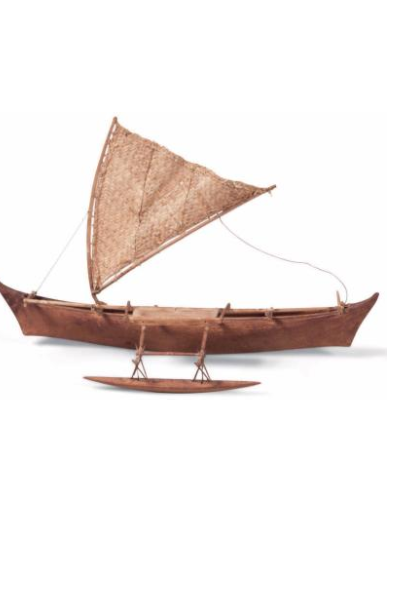








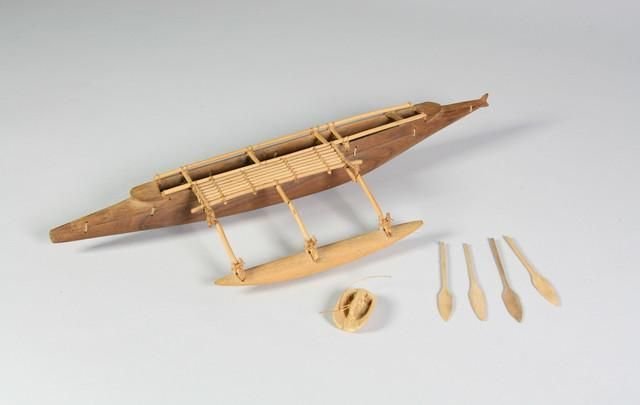



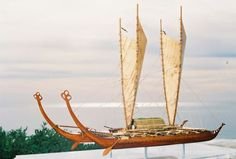


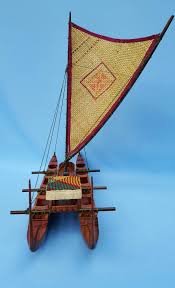


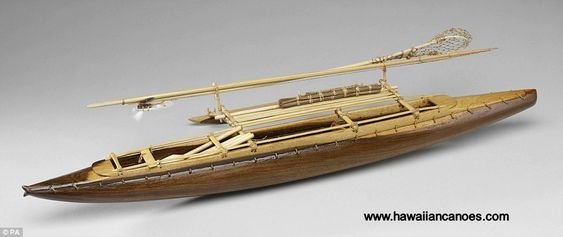


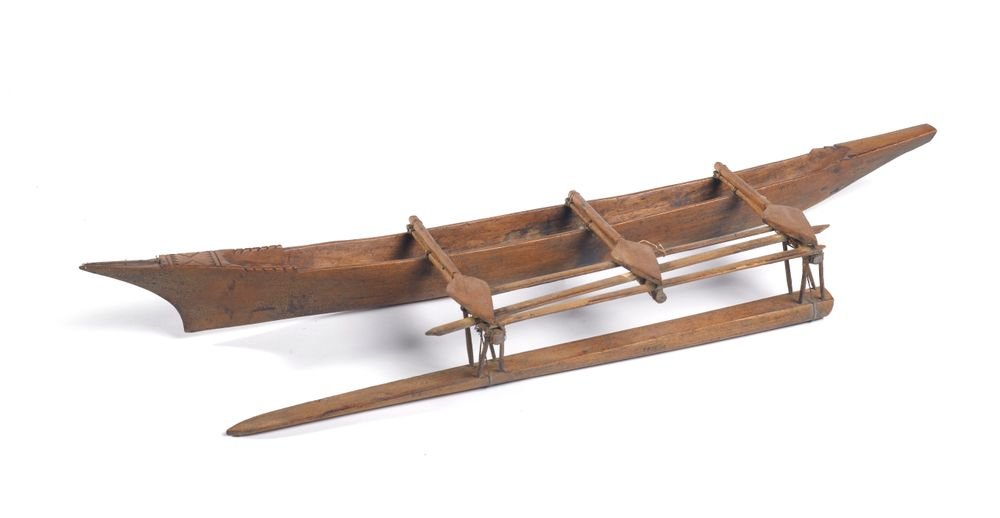







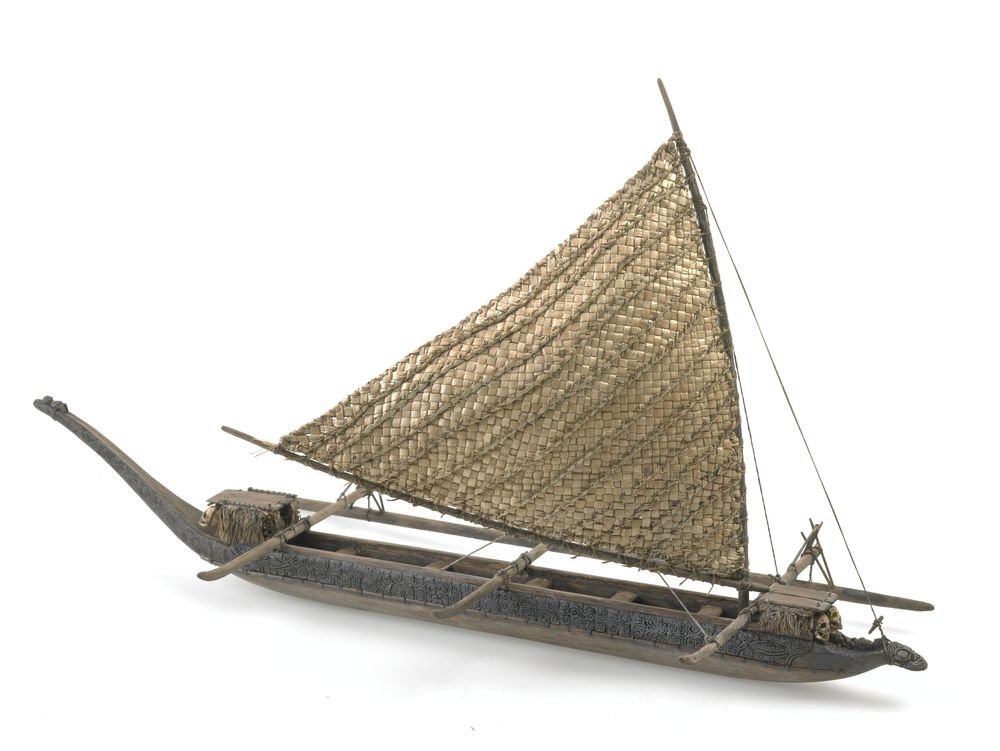
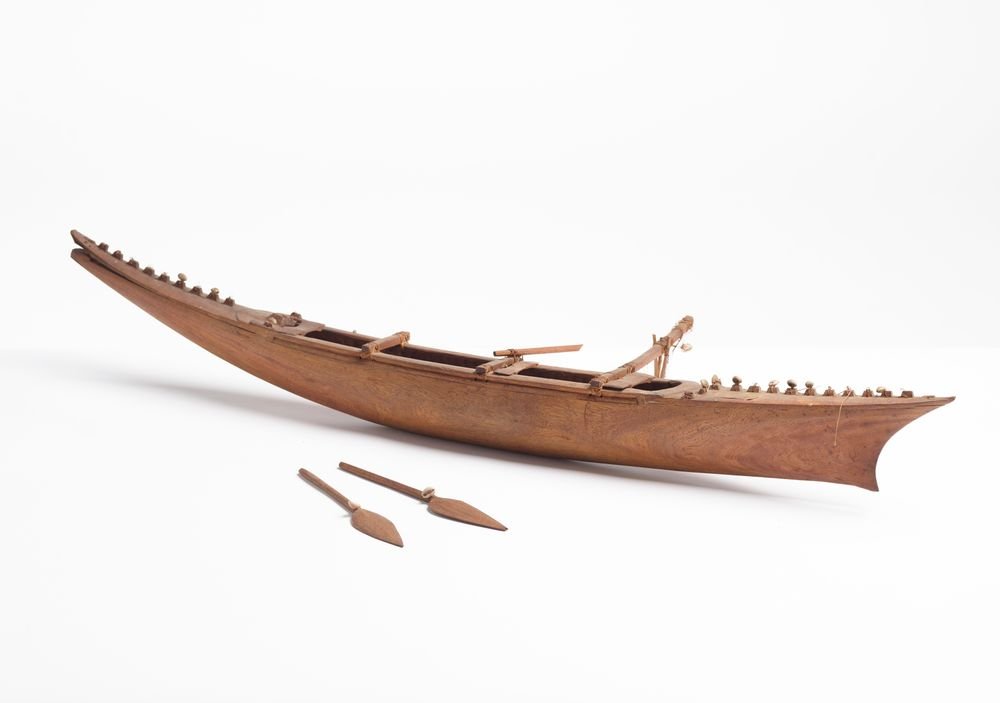





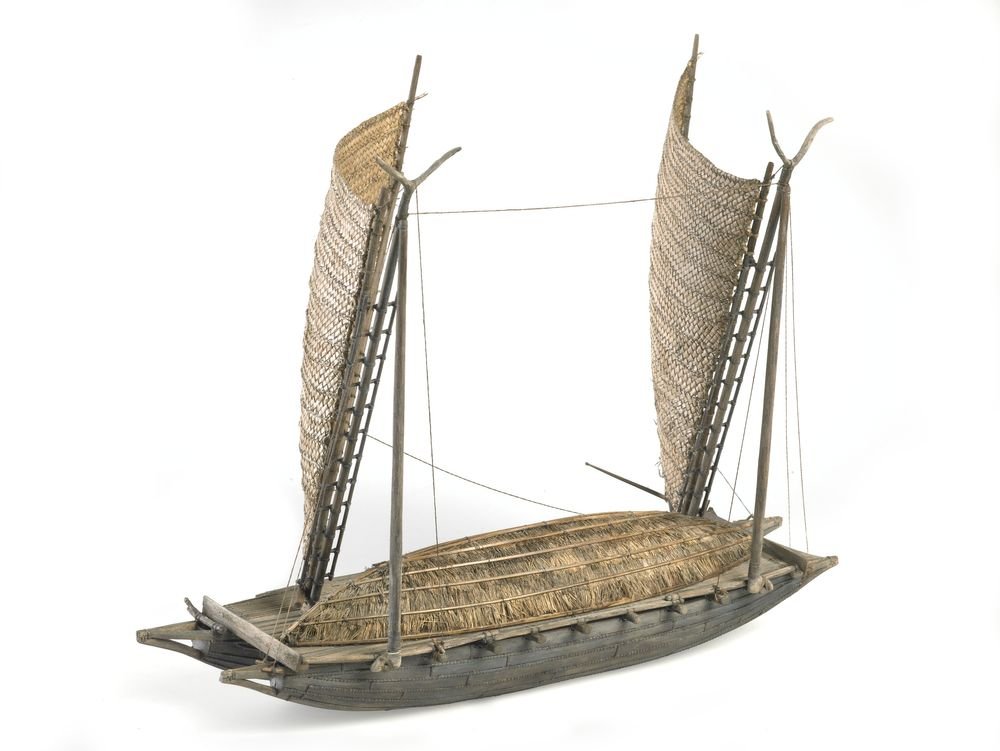


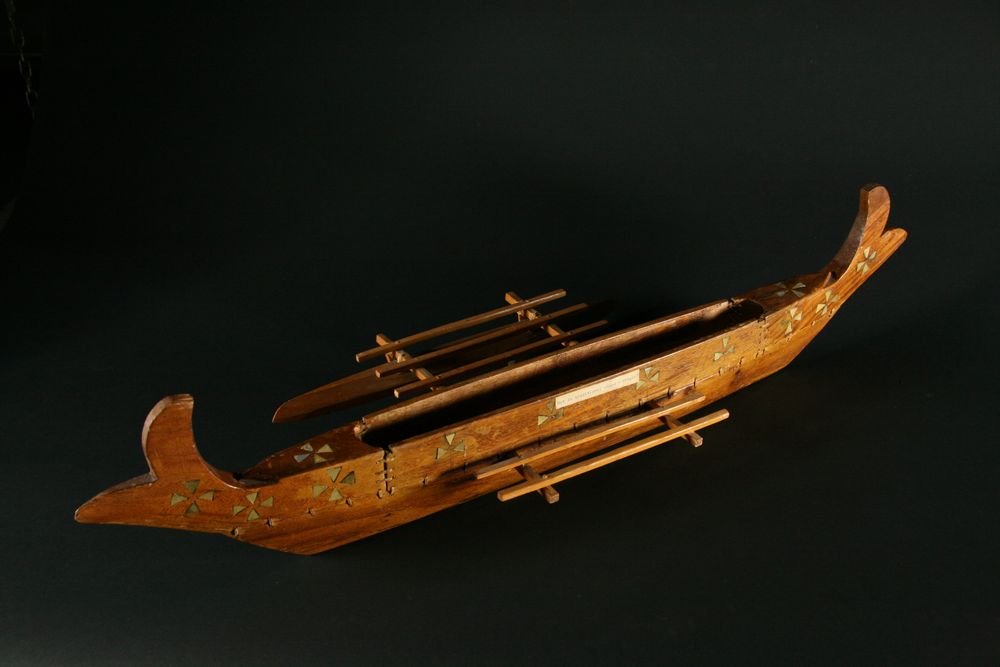

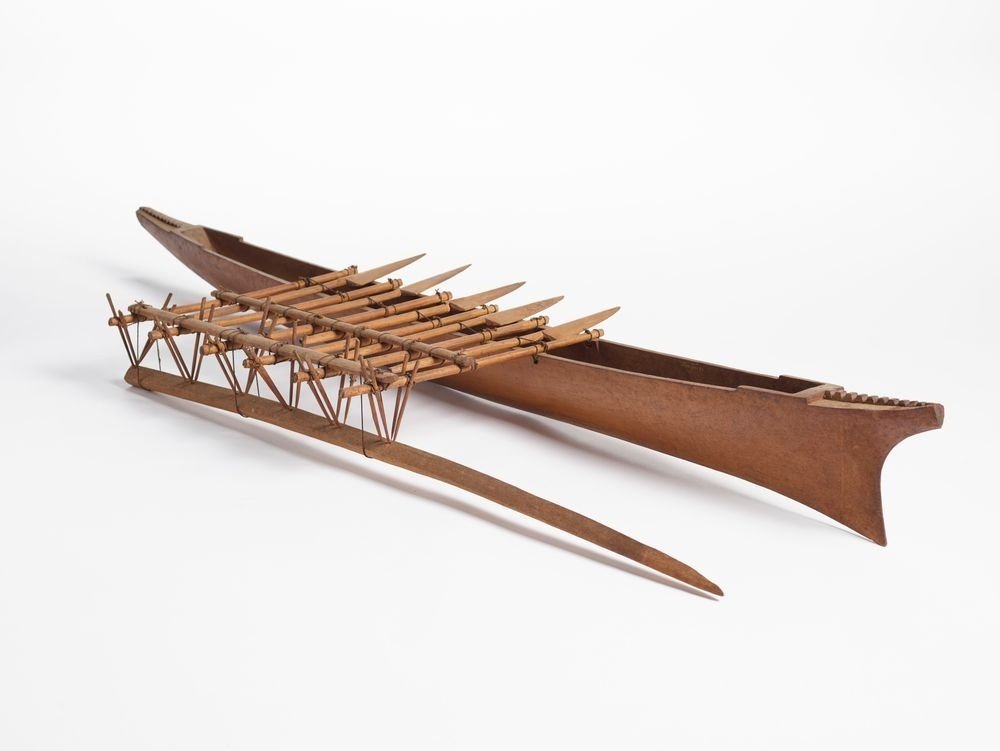




















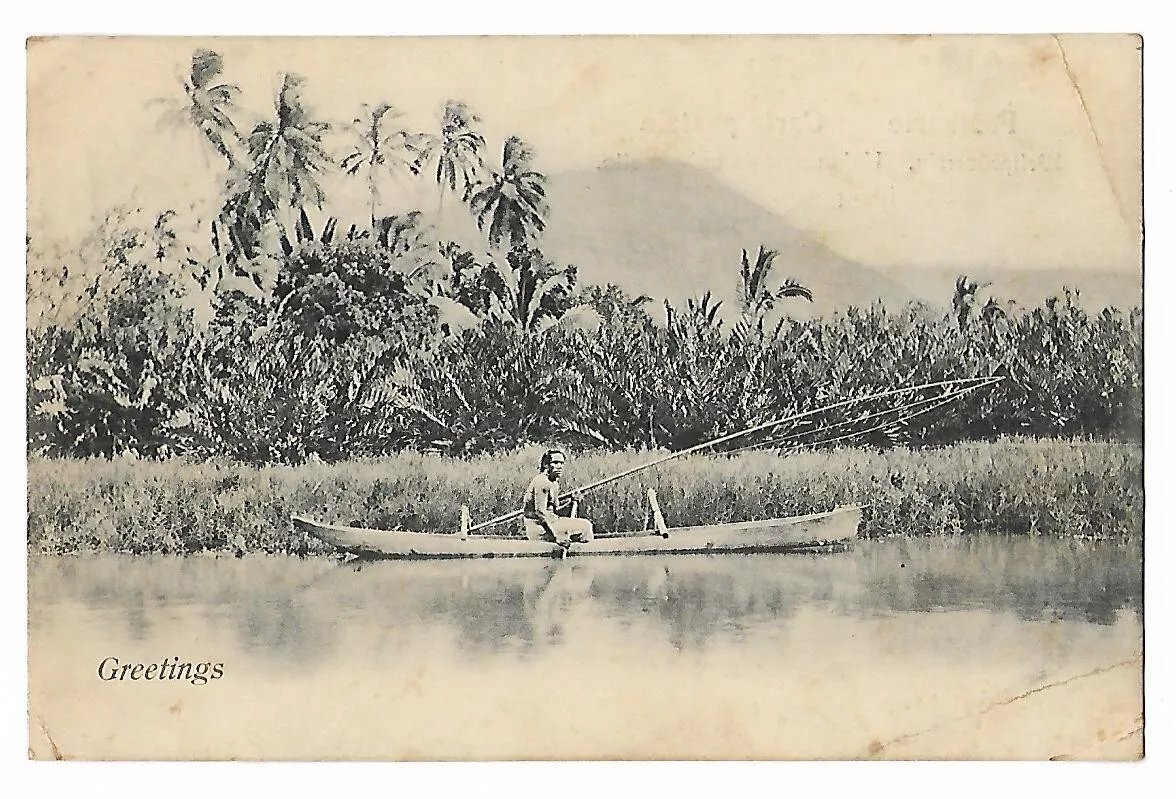
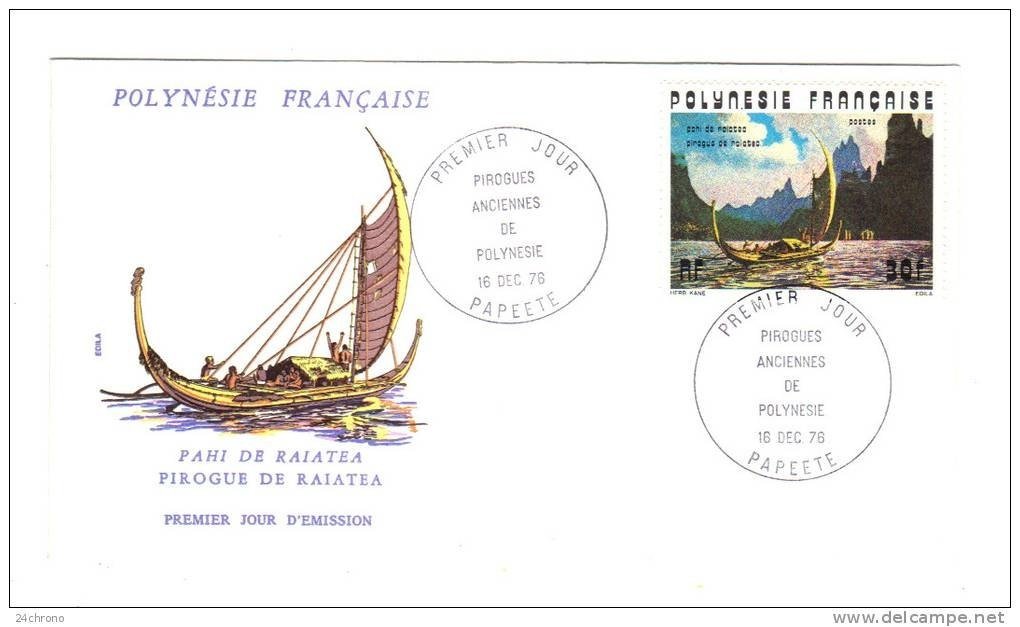

















































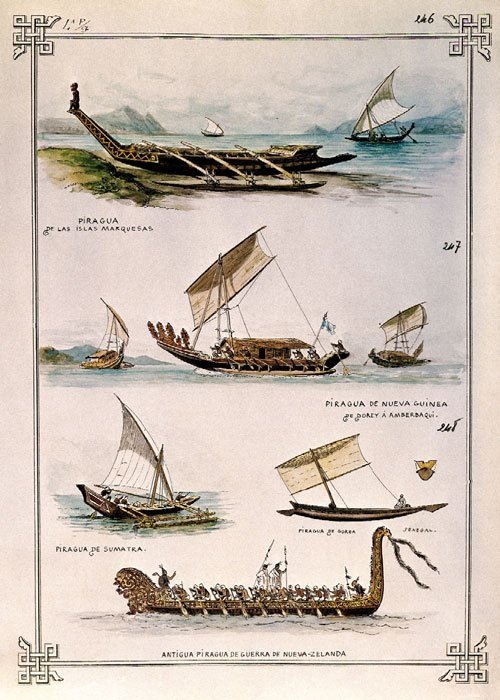












https://en.wikipedia.org/wiki/Polynesian_Triangle
Polynesia is a subregion of Oceania, made up of more than 1,000 islands scattered over the central and southern Pacific Ocean. The indigenous people who inhabit the islands of Polynesia are called Polynesians. They have many things in common, including linguistic relations, cultural practices, and traditional beliefs. In centuries past, they had a strong shared tradition of sailing and using stars to navigate.
Throughout Polynesia and Oceania in general, canoes have been, and in some cases still are, a primary means of transportation between islands. They also serve as an essential method for fishing along the shores. Some canoes were specifically designed to accommodate a large number of warriors for the purpose of waging war and conquering other islands. The size and construction of canoes were greatly influenced by the materials available on each particular island. For example, Hawaii was able to build large voyaging or war canoes using the renowned Koa tree. Meanwhile, the Māori in New Zealand constructed war canoes, known as "Waka Taua," that could be up to 130 feet long, utilizing the massive Kauri or Totara trees. While most canoes, regardless of size, were dugouts, some, particularly in Samoa , were built using plank construction.
Over the last 30 years, I have gathered thousands of pictures illustrating Polynesian canoes, ranging from small fishing canoes to war and voyaging canoes, as well as models of these canoes. It will be a labor of love to list the bulk of them, but I plan to share the most interesting ones over time and list them by island at a later stage.
https://en.wikipedia.org/wiki/Polynesian_Triangle
Polynesia is a subregion of Oceania, made up of more than 1,000 islands scattered over the central and southern Pacific Ocean. The indigenous people who inhabit the islands of Polynesia are called Polynesians. They have many things in common, including linguistic relations, cultural practices, and traditional beliefs. In centuries past, they had a strong shared tradition of sailing and using stars to navigate.
Throughout Polynesia and Oceania in general, canoes have been, and in some cases still are, a primary means of transportation between islands. They also serve as an essential method for fishing along the shores. Some canoes were specifically designed to accommodate a large number of warriors for the purpose of waging war and conquering other islands. The size and construction of canoes were greatly influenced by the materials available on each particular island. For example, Hawaii was able to build large voyaging or war canoes using the renowned Koa tree. Meanwhile, the Māori in New Zealand constructed war canoes, known as "Waka Taua," that could be up to 130 feet long, utilizing the massive Kauri or Totara trees. While most canoes, regardless of size, were dugouts, some, particularly in Samoa , were built using plank construction.
Over the last 30 years, I have gathered thousands of pictures illustrating Polynesian canoes, ranging from small fishing canoes to war and voyaging canoes, as well as models of these canoes. It will be a labor of love to list the bulk of them, but I plan to share the most interesting ones over time and list them by island at a later stage.
Hawaiian canoe
A beautiful model canoe
Hawaiian Canoes
This is an early 20th-century photograph. Notice that the hulls of the canoes are darker than the tops. This difference in color may be due to the hulls being carved from Koa wood, while the gunnels and tops are made from a lighter-colored wood, such as Ahakea.
Hawaiian canoe
A photo dating back to the beginning of the 20th century showing a native paddling along the shore.
Hawaiian outrigger
Another picture issued as a post card towards 1915 showing a canoe fitted with a sprit sail.
The location seems to be near the Hawaiian Outrigger canoe club.
Hawaiian canoe
Small Hawaiian canoe model
Hawaiian Canoe 1915
A picture daring back towards 1915 showing a Hawaiian outrigger canoe fitted with a sprit sail. The Royal Hawaiian Hotel in the distance
Hawaiian fishing canoe
An early 20th century colored postcard showing a Hawaiian using a fishing pole.
Hawaiian canoes
1880's Hawaiians in outrigger canoes Waipi'o Valley, Maui
Hawaiian canoes
1880's Hawaiians in Outrigger Boats Waipi'o Valley Maui
Hawaiian canoes
1880's Hawaiians in Outrigger Boats Waipi'o Valley Maui.
Samoan canoe
Nice little model
Marquesan canoe model
MARQUESAN CANOE hull ornamented with incised patterns as shown in this model. The fore end piece is often carved with a human face whereby the end piece is bearing a recumbent tiki figure.
MANIHIKI , Cook Islands
This particular model of a Manihiki canoe from the Cook Islands is at the Horniman Museum, London. I know of 3 more more models, one at the Scottish Royal Museum, one at the Peabody Museum, Salem and the third at Te Papa Colletions,, NZ.
Hawaiian canoe
This model of an outrigger canoe, fitted with a European sprit sail, resembles closely that of Hawaiian fishing canoe, but at closer inspection it looks to be from Bonin Islands.
SAMOAN BONITO CANOE
I have always regarded this canoe, with its elegant lines, as one of the most beautiful Polynesian fishing canoes. It is not a dugout; it is entirely built from planks. This picture was taken in 1914.
Over the last six years, I have created two large-scale models of this vessel.
Samoan canoe
This is a model of a Samoan canoe of the type “Soatau” I made many years ago. Notice the curved figurhead on which cowry shells were tied.
Cook Islands canoe
This is a small double-hull canoe from the island of Atiu. The small canoes of the Cook Islands share many similarities with Hawaiian fishing canoes, particularly in their shapes, which feature a raised stern and a lower bow piece, known as the manu, at the front. Most notably, the Cook Islanders used wood from the breadfruit tree to construct their canoes.
Samoan double hull canoe
A Samoan double hull voyaging canoe of the type “Alia”. It is the Samoan version of the Fiji Ndrua.
Samoan bonito canoe
Several years ago, I created a wonderful scale model of the Samoan bonito canoe, entirely plank-built and crafted from Koa wood. This model is now displayed in the lobby of the Four Seasons Hotel Resort at Manale Bay, Lana'i, Hawaii.
New-Zealand
This is a “waka tete”, a Maori fishing canoe . The figurehead at the bow of the canoe is a rudely carved representation of a human face sticking out the tongue. The representation of a human body is sitting at the stern of the canoe.
Tuvalu fishing canoe
This is a model canoe replicating a Tuvalu canoe. of the type “Paopao”. Tuvalu, formerly Ellice Islands.`
SAMOAN CANOE
A Samoan canoe model in the Vatican Museums. The canoe has the shape of an “amatasi” type, whereby an amatasi is equipped with only 7 beams and not 8.
1880 NEW-ZEALAND WAR CANOE
A picture dated 1880 showing a Maori war canoe of the type “Waka Pitau”.
NEW-ZEALAND WAR CANOE
Canoe model.
NEW-ZEALAND WAR CANOE
Showing the ornamental carved stern of the canoe or “Tau-rapa”
NEW-ZEALAND WAR CANOE
Showing the ornamental bow of the canoe or “ Tau-ihu”
Cook Islands
Canoe in Rarotonga, Cook Islands. It has a front top very similar to those in Hawaii. Note the carvings along the hull.
TOKELAU
Small fishing canoe model of the type “Paopao”
Cook island canoe
Top view of the “Manihiki” canoe model at the Horniman Museum, London
Cook island canoe
Side view of the “Manihiki” canoe model
Tahiti
Tipairua voyaging canoe
Cook Island
Front view of the Manihiki canoe model at the Horniman Museum, London.
Hawaiian canoe with sprit sail.
This is an early post card showing a canoe near the Outrigger Club.
Maori war canoe
New-Zealand
Hawaiian outrigger canoe
Hawaiian double hull
Hawaiian double hull sailing canoe
Hawaiian double hull
Hawaiian double-hull canoe with crab claw sail
Hawaiian fishing canoe
Hawaiian fishing canoe with striped sail built by F.P. in 2008 for the Kahala Hotel & Resort.
Hawaiian fishing canoe
Small , old canoe model. Outriggers and ama are on the wrong side of the model.
Hawaiian fishing canoe
Beautiful model canoe
Hawaiian outrigger with sprit sail
Mid 1920 photo of a fairly long fishing canoe
Hawaiian outrigger canoe
Hawaiian model canoe
Hawaiian postcard
A beautiful old postcard showing canoes along the Waiakea river, Hilo, Hawaii.
Hawaiian Voyaging single sail
This model was created many years ago for a customer who wanted to use it for decoration on his cruising boat.
Mo'olele sailing canoe
Hawai'iloa
In 1995, Hawaiʻiloa sailed her maiden voyage to Tahiti, Raʻiatea, and Nuku Hiva in the Marquesas Islandsin company with Hōkūleʻa and a third canoe from Hawaiʻi called Makaliʻi together with two canoes from Rarotonga: Te ʻAu Tonga and Takitumu, and the canoe Te ʻAurere, from New Zealand.
Hawaiian outrigger
An early postcard showing paddlers along the Honolulu Haebor.
hokulea
Scale model of Hokule’a with striped sails. Built in 2015 by FP
outrigger
hokulea-jpg.jpg
Hawaiian Fishing Canoe
Hokule'a
This is an 18 inch long scale model of Hokule’a with striped sails. Built by in 2001.
Samoan canoe
Model canoe replicating a type seen on the island of Tutuila.
Hawaiian canoe, Samoan canoe
Those 2 canoes were auctioned off in Waikiki some years ago .
MODÈLE DE CANOÉ, MANIHIKI ATOLL, ILES COOK,...png
Marquesan canoe
Marquesan fishing canoe model with sail by Francis Pimmel. The models is graced with a tiki standing at the stern of the model. Francis was commissioned to build some identical models for The Four Seasons Hotel Resort Suites, Lana’i, Hawaii.
MODÈLE DE CANOÉ, POLYNÉSIE
Samoa
HAWAII
Hawaiian outrigger canoe
Tuvalu canoe
TePapa_Vaka-model-outrigger
Maori
Pirogue de guerre Wangari, New-Zealand
Wangari war canoe model
TE-PAPA COLLECTIONS
Tuvalu canoe
- Marquesan model canoe.jpg
Hawaii
18 inch Opelu canoe by Francis Pimmel
Hawaii
18 inch Opelu canoe with fishing spears by Francis Pimmel
Tuvalu
Formerly “Ellice” Island. Fishing canoe vaka alo from Nui island
Tuvalu canoe
Fiji Camakau
Tuvalu canoe model
Hard to localize but looks to be from Vaitupu which is an atoll in Tuvalu
Marquesan double hull Voyaging canoe.
Maori war canpe
A waka pitau from New Zealand. Te-papa Museum.
Samoa
Beautiful early 20c picture of a Samoan Va’aalo.
Cook Islands double hull model.
A model built by Francis Pimmel some years ago. Private collection
Tuvalu
Showing the typical stern end section of the Funafuti canoes. Tuvalu canoes were traditionally plank built sewn together with coconut fiber rope
cscantik8.jpg
Tuvalu
Fishing canoe vaka alo from the central island NUI
Tuvalu
A Niutao island canoe on exhibit at the Ethnologisches Museum Berlin-Dahlem.
Long by only 12 inches, this scale model of the Hokule'a is shown on its wooden base and covered by a made to size showcase_.jpg
SAMOA
TE-PAPA COLLECTIONS. A va’a alo type Samoan fishing canoe model
Tuvalu
Fishing canoe vaka alo from the northern islands like Nanumanga and Niutao
THE PAPA COLLECTIONS
The Waka hourua “Te Aurere Iti is model voyaging canoe replicating the Aurere Iti which sailed to Rarotonga in 1992 and to Tahiti and Hawaii in 1995. The canoe was moored at Pier 41.
SAMOA
A “Va’aalo” canoe in the lobby of the Kitano Hotel, Apia
Tuvalu
A northern canoe.
Tuvalu
Line drawings and tGerman terminology of the various canoe parts
Ethnologisches Museum Berlin-Dahlem
Front to back: Samoan Va’aalo or bonito fishing canoe, a Tuvalu vaka alo or large Tuvalu fishing canoe from Niutao island, A te puke or ocean going canoe with crab-claw sail from Taumako/Nifiloli, Santa-Cruz islands, and a Micronesian canoe from Jaluit, Marshall Islands on the left.
"Taumako Nifiloli" likely refers to the voyage of the "Te Puke" (also known as "Vaka Taumako") canoe, which sailed from Taumako (Duff Islands) to Nifiloli in the Outer Reef Islands, and then back to Taumako
Hawaiian Fishing canoe model
Showing a 12 inch long Hawaiian Fishing canoe model by F.P.
MARQUESAS
TE-PAPA COLLECTIONS. A model-vaka-tou’ua ,sailing canoe from Marquesas
SAMOA
Te-Papa Collections. Samoan Va’aalo fishing canoe
A 12 inch long scale model of Hokule'a
Visit the “SHOP”for more information.
hawaiian-fishing-canoe
A canoe in his “auha” or canoe shelter.
Honolulu Harbor.jpg
SAMOA
Samoan VA’AALO or bonito fishing canoe from the Te-Papa Tongarewa collections, Museum of New Zealand. The Va’aalo were entirely plank built.
Visit THE GALLERY to peruse a scale model I built a few years ago for a collector.
IMG_0101.JPG
TUAMOTU
A pahi sailing canoe model in the TE-PAPA collections. Apparently there is also a model at the Bishop Museum, Honolulu, as well as in the Louvre, Paris.
Those double-hulled voyaging canoes were long by 40 feet with a beam of 11 feet. The canoe could take up to 16 people on board.
TONGA
A very large “Kalia” type canoe which is the Tongan adaptation of the drua or double-hulled Fijian voyaging canoe.
SOCIETY ISLANDS (TAHITI)
TE-PAPA COLLECTIONS. _ModelDouble-Hulled Canoe Vaka, Society island.
COOK ISLANDS
Te-Papa Collections. Cook islands canoe
HAWAII
Native Hawaiian pushing his canoe onto the shore. Postcard ca 1910
SAMOA
Te-Papa Collections.
NEW-ZEALAND
Maori war canoe. Postcard
MAORI
New Zealand war canoe by Dumont D'Urville 1841.
Jules Sébastien César Dumont d'Urville was a French explorer and naval officer who explored the south and western Pacific, Australia, New Zealand and Antarctica. As a botanist and cartographer, he gave his name to several seaweeds, plants and shrubs and to places such as d'Urville Island in New Zealand.
MAORI
New-Zealand war canoe
MAORI
NEW-ZEALAND
A crowd admiring a Maori war canoe. An illustration dated 1866
MAORI
NEW-ZEALAND
Auckland Harbour Regatta by Frederick Rice Stack
NEW-ZEALAND
Maori war canoe
MARQUESAS
Small model of a Marquesan voyaging canoe or “Vaka, Va’a, sometimes equipped with a sail.
NEW-ZEALAND
Traditional Maori waka Haunui, double-hulled canoe in the Te-Papa Tongarewa Museum, Wellington, New-Zealand. Illustration by Pierre André Leclercq.
MARQUESAS
Single hull Marquesan canoe model by Francis Pimmel
NEW-ZEALAND
New-Zealand Maori war canoe “waka-taua” by James-Cook, copper engraving 1774, but hand colored at a later date.
WALLIS & FUTIUNA
Small Futuna Island canoe model
TAHITI
A View of Matavai Bay in the Island of Otaheite Tahiti, William Hodges, 1744–1797, British, 1776, Oil on canvas. (Photo by: Sepia Times/Universal Images Group via Getty Images)
TAHITI
William Anderson - A Pahie engraved by Thomas Milton (1743-1827) 1820
NZ War canoe.jpg
Tahiti
MARQUESAS
The painting of a “Waka Tou’ua” by Herb Kawainui Kane .
TUAMOTU
A pahi model.
TUAMOTU
Pahi Drawing by Admiral Paris
SAMOA
A Va’aalo canoe
SOCIETY ISLANDS
A First-day cover issued in Papeete showing a Raiatea canoe.
Tonga
Tongan Kalia
HAWAII
Native Hawaiian coming to shore.
Tuamotu
A Pahi model.
HAWAII
Hawaiian outrigger with sprit sail
HAWAII
Flying the ama.
pu-uhonua-o-honaunau.jpg
The refuge of birth
SAMOA
Small fishing canoe model of the type Va’a alo.
TAHITI
TAHITI
Native throwing spear on bord a “tipai-Hoe”
SAMOA
NEW-ZEALAND
An illustration by by Dumont D'Urville 1841, showing Maori canoes of the type “Waka Tete” or fishing canoes approaching a sailing ship.
Nouvelle-Zealande.jpg
New Zealand War Canoe. Waka Taua, Maori James Cook Print 1774. Original engraving in black and white.
NEW-ZEALAND
A Maori war canoe by Parkinson Sydney.
Original 1920 photograh about Hawaiian canoes.jpg
NEW-ZEALAND
Historical lithograph totles “Vue du Cap Wangari, Nouvelle Zelande, depicting a view of Cape Wangatrei in the Bay of Islands, New-Zealand, with Maoris rowing a war canoe.
TAHITI
Who is William Hodges ?
HAWAII
A rare magic lantern slide from the end of the 19 c showing Hawaiian paddlers pushing racing canoes onto shore.
SAMOA
FP COLLECTION.
s-l1600 (20) (1).jpg
MARQUESAS
A 38 inch long model of a double-hulled Marquesan Voyaging canoe built by Francis Pimmel.
Samoa3.jpg
SAMOA
A postcard illustrating a Samoan Va’a alo fishing canoe.
SAMOA
The Fautasi race . This is a traditional Samoan canoe race that takes place on Flag Day, a national holiday in American Samoan. The canoe is actually a derivative , in shape and form, from the early whaling boats. These boats were long and narrow, with sharp ends.
SAMOA
Native Samoan aboard a Va’a alo fishing canoe
TAHITI
john Webber,, R.A. (1751-1793) Aquatint engraving with original hand color. A Sailing Canoe of Otaheite, Plate 3.
Who was John Webber ?
SAMOA
Va’a alo model canoe
SAMOA
A Va’a alo canoe on the left and a Tokelau fishing canoe vaka on the right.
SAMOA
Small Samoan va’a alo model canoe
SAMOA
Beautifully preserved va’a alo canoe.
SAMOA
A Va’a alo at display in the Tradewinds Hotel, Tutuila..jpg
SAMOA
A beautifully preserved Va’ a alo in the Tradewinds Hotel, Tituila, Samoa
SAMOA
Samoa. seven outrigger canoe model in the Vatican Museums . A canoe of the type “amatasi”
SAMOA
Model canoe from the island of Tutuila
Samoa. Model de pirogue paopao Galerie Flack.jpg
SAMOA
Va’a alo canoe model.
SAMOA
Samoan “Kalia” model
SAMOA
Samoan Voyaging canoe by Francis Pimmel. Property of the Four Seasons Hotel Resort, Lana'i. On display in the lobby of the Resort.
SAMOA
Samoan canoe of the type Kalia. Double-hulled canoes were introduced to Samoa in the 19th century due to Tongan influence. They are identical in every way to Tongan double-hulled canoes, which were themselves modeled after the Fijian Dru canoe.
SAMOAN
Va’a alo model canoe
TUVALU
Fishing canoe “Vaka Alo”
TAHITI
Tahitian outrigger with sprit sail
MARQUESAS
Resolution Bay in the Marquesas (unfinished state)
This engraving, after drawings by artist William Hodges, is from the account of Cook's second voyage, 1772-75, [not, as previously stated here Hawkesworth's account of the first, published in 1773].
Captain James Cook (1728-1779) made three separate voyages to the Pacific (with the ships Endeavour, Resolution, Adventure, and Discovery) and did more than any other voyager to explore the Pacific and Southern Ocean. Cook not only encountered Pacific cultures for the first time, but also assembled the first large-scale collections of Pacific objects to be brought back to Europe. He was killed in Hawaii in 1779.
William Hodges (1744 - 1797) joined Cook's second expedition to the South Pacific as a draughtsman 1772-75 and was employed by the Admiralty in finishing his drawings.
Cook traveled to the Marquesas in March of 1774. This drawing was likely done by Hodges between the 8th and 12th of April, 1774. The islanders in the canoe wear head-dresses of grass.
As recorded in Hawkesworth's account: ' Their canoes were made of wood and pieces of the Bark of a soft wood, which grows near the Sea in great plenty, and is very tough and proper for the purpose; They are from 16 to 20 feet long and about 15 inches broad. The head and stern is made of two pieces of Wood, the Stern rises or curves a little, but in an irregular direction and ends in a point; the head projects out horizontally and is car[v]ed into some faint and very rude resemblance of a human face. They are rowed by Paddles and some have a sort of Latteen sail made of Mating.' Cook, Journals II, 12 April, 1774.
Royal Museums Greenwhich
SAMOA
Samoan canoe model of the type va’a alo.
TAHITI
Steel engraving 1842 by Amiral Paris while circumnavigating the world on board Artemise.
TAHITI
1792 engraving SOUTH SEA Society Islands w VIEW of OTAHEITE
Marquesan print.jpg
outrigger-canoes-and-men-fishing-1885-taken-by-francis-sinclair-9a872b-640.jpg
Tahiti.JPG
SOCIETY ISLANDS
Painting. Beach of Raiatea by Coulon, around 1906.
Marquesan+print.jpg
Jules Dumont D’Urville
MARQUESAS
TAHITI
TAHITI
A large Tipairua canoe model built by Francis Pimmel. The model is now in a large private canoe collection in Los Angeles.
Tahitian-Double-Canoe-Made-In-17777
Te Papa - voyaging canoe of Kupe the Explorer.
In Māori tradition, Kupe, a legendary explorer, is said to have discovered New Zealand using his voyaging canoe, the Matawhaorua. Kupe, with his wife, family, and crew, traveled from their ancestral homeland of Hawaiki, using stars and ocean currents for navigation. The Matawhaorua was a double-hulled canoe, also known as a waka hourua. The above illustrated canoe is actually a Tahitian Tipairua.
It is strange to me why the Tapa Tongarewa Museum is using a Tipairua canoe as an example of how the Matawhaorua may have looked.
TAHITI
A fully planked canoe model with the bow and stern extremities decorated with a tiki. The tikis should be looking inside the canoe.
NIU ISLAND
Te Papa collections. The shape of the Niu island canoes is similar to the one of Tuvalu
SAMOA
Samoan Paopao type model canoe.
Te Toki-a-Tapiri
Tokelau Island canoe model
Tokelau Island canoe mode prow
Tokelau Island Outrigger Canoe Model